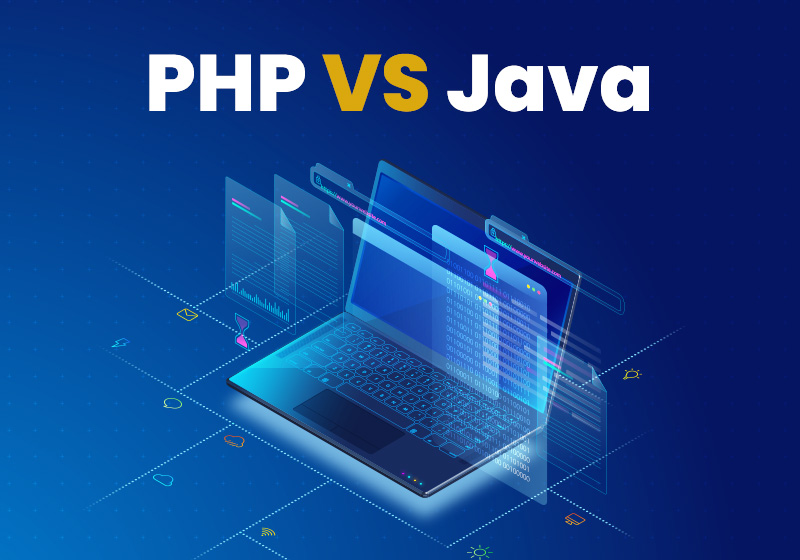PHP vs Java
PHP vs Java – Which is the Best Choice for Website Development?
 Updated 18 Apr 2024
Updated 18 Apr 2024

Using the latest and the best programming languages can let your business gain a sizable advantage over the competition by creating software applications that improve work efficiency, extend market reach, and market penetration, and bring a “wow” factor to customers.
Incorporating technological advancements into your business helps your operations to evolve and keep pace with today’s dynamic business world where every day is a fight to hold the customers’ attention.
Be it building applications that run on mobile platforms, software as a service, games, websites, or even entire operating systems; choosing the programming language that fits best for your purposes can be critical to the success and efficiency of your efforts.
In this article, we investigate the key differences between two popular and promising programming languages – Java and PHP to furnish you with the information necessary to choose a fitting language for your next project.
Brief History of Java and PHP
Java, conceived in the early 1990s by James Gosling, Mike Sheridan, and Patrick Naughton, initially aimed at interactive television but found its stride as a versatile, platform-independent language. Meanwhile, PHP, born out of Rasmus Lerdorf’s simple tools for his website in the late 1990s, swiftly evolved into a dominant force in web development. Both languages have since undergone significant evolution, with Java powering critical backend systems and mobile applications, while PHP remains the backbone of countless websites worldwide, demonstrating the enduring impact and versatility of these foundational programming languages in the ever-changing landscape of technology
PHP vs Java Comparison Table
| Feature | Java | PHP |
|---|---|---|
| Paradigm | Treats computation as the evaluation of mathematical functions | Linear top-down list of steps for a computer to process |
| Language Type | Compiled | Interpreted |
| Memory Management | Automatic Garbage Collection | Manual Memory Management |
| Code Compilation | Compiled code executed by the JVM | Interpreted code executed by a PHP interpreter |
| Exception handling | Checked exceptions must be caught or declared | Exceptions can be caught, but not required |
| Concurrency | Multithreading and parallel processing support | Supports multithreading but not parallel processing |
| Type system | Strongly-typed. Each type of data is predefined | Weakly-typed. The type of entity is flexible and can be changed |
| Standard libraries | Rich and Extensive | Basic and Limited |
| Database connectivity | JDBC for connecting to databases | PDO, MySQLi, and other extensions |
| Popular frameworks | Spring, Hibernate, Struts, Apache Maven | Laravel, Symfony, CodeIgniter, Composer |
| Memory usage | More memory-intensive | Less memory-intensive |
| Learning curve | The steep learning curve for beginners | Relatively easy to learn for beginners |
| Full-stack capability | Can serve both client and server sites | Serves only the backend of the website |
| Learning difficulty | Faster but difficult to learn | Slower but easy to learn |
| Security | Less securable code | Highly securable |
| Database access | Requires environment for database access | Allows easy and direct access to the database |
| Threading model | Single-threaded language with concurrent IO operations | Multi-threaded language with blocking IO operations |
| Code embedding | JS code can be embedded in HTML, XML, AJAX | PHP code can only be embedded with HTML |
| Feature support | Supports fewer features | Supports comparatively more advanced features |
| Popular frameworks | Angular, React, Vue.js, Meteor | Laravel, Symfony, FuelPHP, CakePHP, and others |
| Example websites | Twitter, LinkedIn, Amazon | WordPress, Tumblr, MailChimp, iStockPhoto, and others |
Summary of Comparison – PHP vs Java
Java
Java demonstrates excellence in providing reliability, security, and the ability to handle high traffic. Its “Write Once, Run Anywhere” (WORA) concept is a godsend for Website Development Services as it reduces repetitive work greatly. The language is compiled into bytecode which is then interpreted by the JVM interpreter. (hence considered both interpreted and compiled).
Developed by Sun Microsystems in 1995, Java has been a very popular choice among programmers for close to three decades now.
Popular frameworks:
Spring, Hibernate, Struts, Apache Maven
When to use:
- For back-end development meant to run on servers
- For large organizations
- For handling high-traffic
- For handling high-traffic
PHP
PHP is popular as a back-end scripting language and among full-stack developers. Its most notable advantage in Website Application Development is its ability to create web pages that display different content each time they’re viewed while keeping the same design. It is compatible with several databases and lets you view what the code is doing in real time to ease debugging.
An important point of note is that interpreted languages such as PHP were once significantly slower than compiled languages, but this gap has shrunk greatly thanks to just-in-time(JIT) compilation. It identifies frequently used code, and instead of interpreting bytecode every time, will invoke this object code instead.
Popular frameworks:
Laravel, Symfony, CodeIgniter, Composer
When to use:
- For programs that run on a web server
- Lets you generate dynamic web pages with a personalizable user experience.
- For Command-line scripting
- For building desktop applications
Compiled Language vs Interpreted Language
Though every program is but a set of instructions that we give to the computer, it is the compilers and interpreters that convert that code into one that can be read by the machine.
The compiler and interpreter as the names suggest, differ in the manner in which they carry out this task. While a compiler converts the entirety of the code directly into machine code for the processor to execute all at once, an interpreter does so line by line.
This difference leads to a variety of advantages and disadvantages that are listed below. One should take note, however, that several programming languages can have both compiled and interpreted implementations, for simplicity’s sake, they’re typically referred to as such.
| Characteristic | Compiled | Interpreted |
|---|---|---|
| Process | Once compiled, the program is expressed as instructions for the target machine | The target machine does not directly execute the instructions |
| Compilation Steps | At least two steps to get from source code to execution | Single step from source code to execution |
| Error Handling | Compilation errors will prevent the code from compiling | All debugging occurs at run-time |
| Flexibility | Programs need to be rebuilt for every change | The code can be modified |
| Program Size | Comparatively larger program size | Smaller program size |
| Execution Speed | Tend to be faster than interpreted code | Execution speed is comparatively slower |
| Examples | Java, C, C++, C#, CLEO, COBOL | PHP, Javascript, Perl, Python, BASIC |
Transform Your Development Projects With Q3 Technologies
Empower your development journey with Q3 Technologies, where innovation meets expertise. From groundbreaking solutions to seamless project execution, we’re here to elevate your development projects to new heights. Whether you’re leveraging the flexibility of PHP for dynamic web applications or harnessing the power and portability of Java for enterprise-level software solutions, we’ve got you covered. With our proven track record of delivering excellence, personalized approach, and cutting-edge technologies, we ensure your success every step of the way.
Let’s embark on a transformative journey together, where your vision meets our passion for innovation.
Explore More

Web Development
8 Tips for Choosing the Right Web Development Company

Artificial Intelligence

